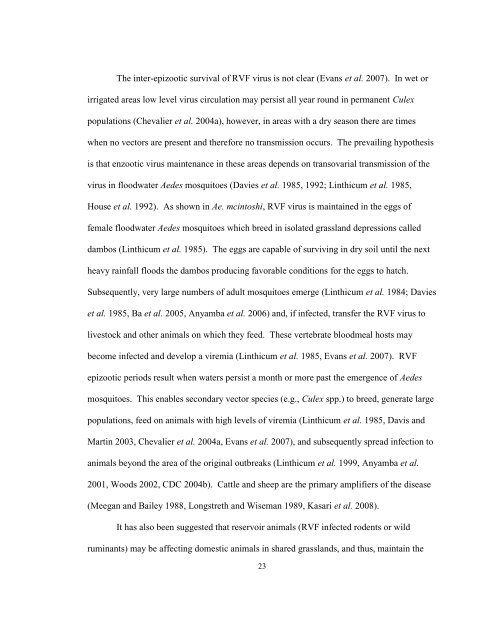Sample A: Cover Page of Thesis, Project, or Dissertation Proposal
Sample A: Cover Page of Thesis, Project, or Dissertation Proposal
Sample A: Cover Page of Thesis, Project, or Dissertation Proposal
Create successful ePaper yourself
Turn your PDF publications into a flip-book with our unique Google optimized e-Paper software.
The inter-epizootic survival <strong>of</strong> RVF virus is not clear (Evans et al. 2007). In wet <strong>or</strong><br />
irrigated areas low level virus circulation may persist all year round in permanent Culex<br />
populations (Chevalier et al. 2004a), however, in areas with a dry season there are times<br />
when no vect<strong>or</strong>s are present and theref<strong>or</strong>e no transmission occurs. The prevailing hypothesis<br />
is that enzootic virus maintenance in these areas depends on transovarial transmission <strong>of</strong> the<br />
virus in floodwater Aedes mosquitoes (Davies et al. 1985, 1992; Linthicum et al. 1985,<br />
House et al. 1992). As shown in Ae. mcintoshi, RVF virus is maintained in the eggs <strong>of</strong><br />
female floodwater Aedes mosquitoes which breed in isolated grassland depressions called<br />
dambos (Linthicum et al. 1985). The eggs are capable <strong>of</strong> surviving in dry soil until the next<br />
heavy rainfall floods the dambos producing fav<strong>or</strong>able conditions f<strong>or</strong> the eggs to hatch.<br />
Subsequently, very large numbers <strong>of</strong> adult mosquitoes emerge (Linthicum et al. 1984; Davies<br />
et al. 1985, Ba et al. 2005, Anyamba et al. 2006) and, if infected, transfer the RVF virus to<br />
livestock and other animals on which they feed. These vertebrate bloodmeal hosts may<br />
become infected and develop a viremia (Linthicum et al. 1985, Evans et al. 2007). RVF<br />
epizootic periods result when waters persist a month <strong>or</strong> m<strong>or</strong>e past the emergence <strong>of</strong> Aedes<br />
mosquitoes. This enables secondary vect<strong>or</strong> species (e.g., Culex spp.) to breed, generate large<br />
populations, feed on animals with high levels <strong>of</strong> viremia (Linthicum et al. 1985, Davis and<br />
Martin 2003, Chevalier et al. 2004a, Evans et al. 2007), and subsequently spread infection to<br />
animals beyond the area <strong>of</strong> the <strong>or</strong>iginal outbreaks (Linthicum et al. 1999, Anyamba et al.<br />
2001, Woods 2002, CDC 2004b). Cattle and sheep are the primary amplifiers <strong>of</strong> the disease<br />
(Meegan and Bailey 1988, Longstreth and Wiseman 1989, Kasari et al. 2008).<br />
It has also been suggested that reservoir animals (RVF infected rodents <strong>or</strong> wild<br />
ruminants) may be affecting domestic animals in shared grasslands, and thus, maintain the<br />
23




![[Sample B: Approval/Signature Sheet] - George Mason University](https://img.yumpu.com/21978828/1/190x245/sample-b-approval-signature-sheet-george-mason-university.jpg?quality=85)


![[Sample B: Approval/Signature Sheet] - George Mason University](https://img.yumpu.com/18694905/1/190x245/sample-b-approval-signature-sheet-george-mason-university.jpg?quality=85)






![[Sample B: Approval/Signature Sheet] - George Mason University](https://img.yumpu.com/18694552/1/189x260/sample-b-approval-signature-sheet-george-mason-university.jpg?quality=85)


![[Sample B: Approval/Signature Sheet] - George Mason University](https://img.yumpu.com/18694474/1/190x245/sample-b-approval-signature-sheet-george-mason-university.jpg?quality=85)